NURS3011: Gibbs Reflective Cycle on Mass Casualty Simulation, Hospital
VerifiedAdded on 2023/06/04
|6
|1886
|269
AI Summary
This reflective essay details a nursing student's experience during a mass casualty simulation involving a hospital fire. Using Gibbs' reflective cycle, the student describes their role as a triage nurse, focusing on the challenges of assessing and treating patients with varying injuries, particularly a patient with a head injury. The reflection highlights the importance of A-G assessment, triage sieve and sort, and effective communication within a team. The student analyzes their performance, acknowledging initial nervousness and the need to develop self-confidence and assertive skills. The essay concludes with an action plan for future improvement, emphasizing a commitment to continuous learning and seeking mentorship to enhance professional practice. The student learned the importance of quick thinking, teamwork and constant learning in the nursing profession.
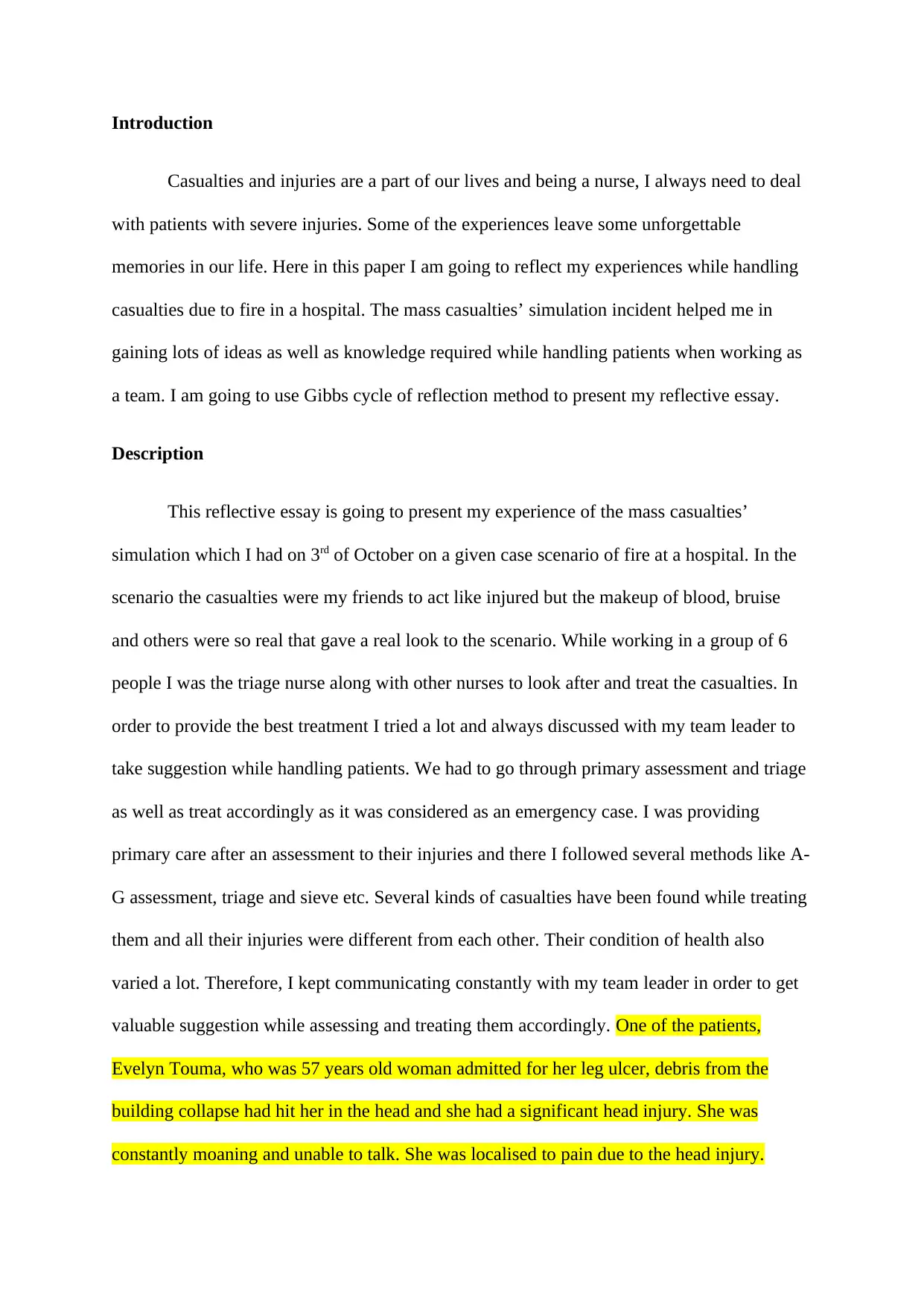
Introduction
Casualties and injuries are a part of our lives and being a nurse, I always need to deal
with patients with severe injuries. Some of the experiences leave some unforgettable
memories in our life. Here in this paper I am going to reflect my experiences while handling
casualties due to fire in a hospital. The mass casualties’ simulation incident helped me in
gaining lots of ideas as well as knowledge required while handling patients when working as
a team. I am going to use Gibbs cycle of reflection method to present my reflective essay.
Description
This reflective essay is going to present my experience of the mass casualties’
simulation which I had on 3rd of October on a given case scenario of fire at a hospital. In the
scenario the casualties were my friends to act like injured but the makeup of blood, bruise
and others were so real that gave a real look to the scenario. While working in a group of 6
people I was the triage nurse along with other nurses to look after and treat the casualties. In
order to provide the best treatment I tried a lot and always discussed with my team leader to
take suggestion while handling patients. We had to go through primary assessment and triage
as well as treat accordingly as it was considered as an emergency case. I was providing
primary care after an assessment to their injuries and there I followed several methods like A-
G assessment, triage and sieve etc. Several kinds of casualties have been found while treating
them and all their injuries were different from each other. Their condition of health also
varied a lot. Therefore, I kept communicating constantly with my team leader in order to get
valuable suggestion while assessing and treating them accordingly. One of the patients,
Evelyn Touma, who was 57 years old woman admitted for her leg ulcer, debris from the
building collapse had hit her in the head and she had a significant head injury. She was
constantly moaning and unable to talk. She was localised to pain due to the head injury.
Casualties and injuries are a part of our lives and being a nurse, I always need to deal
with patients with severe injuries. Some of the experiences leave some unforgettable
memories in our life. Here in this paper I am going to reflect my experiences while handling
casualties due to fire in a hospital. The mass casualties’ simulation incident helped me in
gaining lots of ideas as well as knowledge required while handling patients when working as
a team. I am going to use Gibbs cycle of reflection method to present my reflective essay.
Description
This reflective essay is going to present my experience of the mass casualties’
simulation which I had on 3rd of October on a given case scenario of fire at a hospital. In the
scenario the casualties were my friends to act like injured but the makeup of blood, bruise
and others were so real that gave a real look to the scenario. While working in a group of 6
people I was the triage nurse along with other nurses to look after and treat the casualties. In
order to provide the best treatment I tried a lot and always discussed with my team leader to
take suggestion while handling patients. We had to go through primary assessment and triage
as well as treat accordingly as it was considered as an emergency case. I was providing
primary care after an assessment to their injuries and there I followed several methods like A-
G assessment, triage and sieve etc. Several kinds of casualties have been found while treating
them and all their injuries were different from each other. Their condition of health also
varied a lot. Therefore, I kept communicating constantly with my team leader in order to get
valuable suggestion while assessing and treating them accordingly. One of the patients,
Evelyn Touma, who was 57 years old woman admitted for her leg ulcer, debris from the
building collapse had hit her in the head and she had a significant head injury. She was
constantly moaning and unable to talk. She was localised to pain due to the head injury.
Paraphrase This Document
Need a fresh take? Get an instant paraphrase of this document with our AI Paraphraser
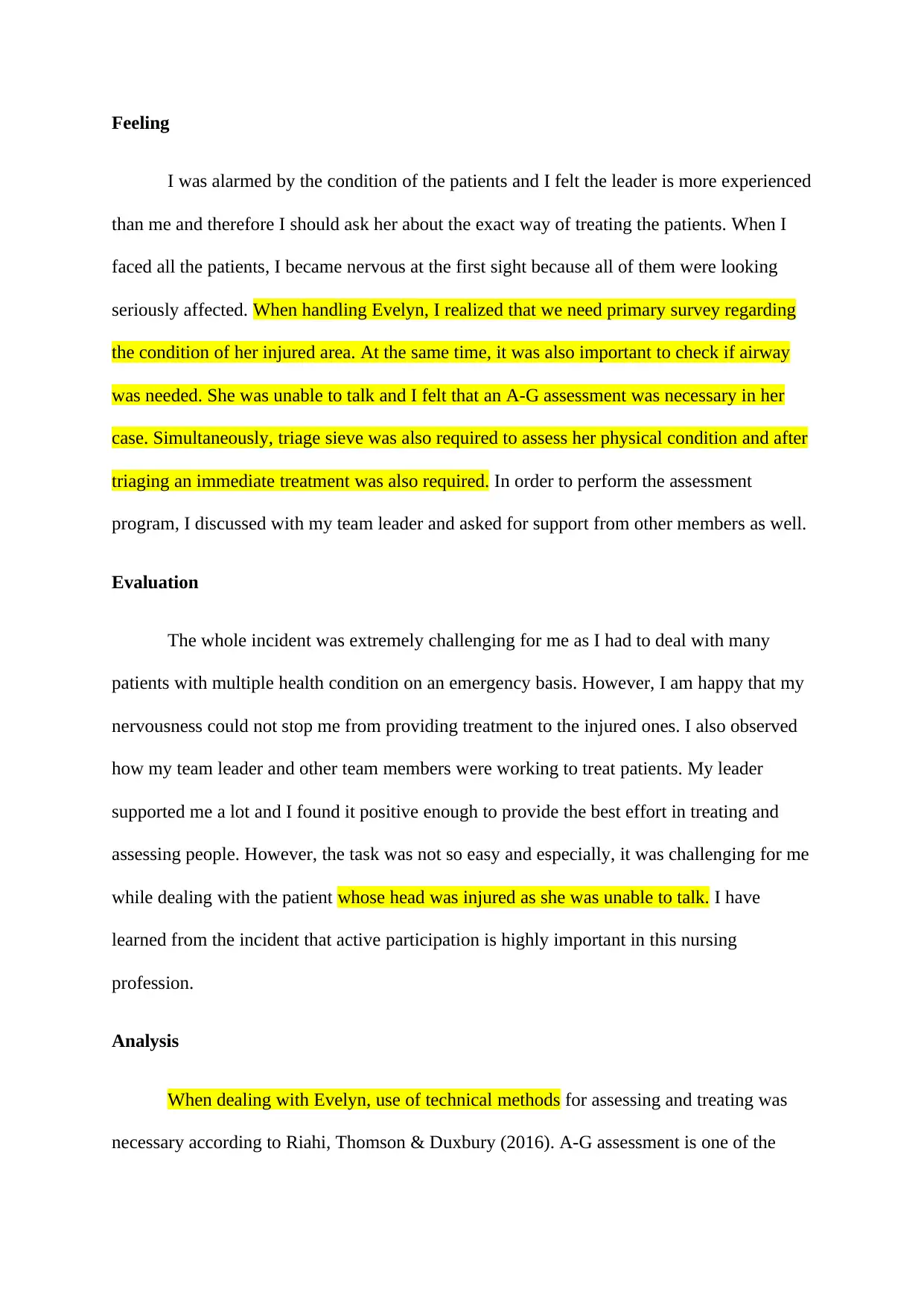
Feeling
I was alarmed by the condition of the patients and I felt the leader is more experienced
than me and therefore I should ask her about the exact way of treating the patients. When I
faced all the patients, I became nervous at the first sight because all of them were looking
seriously affected. When handling Evelyn, I realized that we need primary survey regarding
the condition of her injured area. At the same time, it was also important to check if airway
was needed. She was unable to talk and I felt that an A-G assessment was necessary in her
case. Simultaneously, triage sieve was also required to assess her physical condition and after
triaging an immediate treatment was also required. In order to perform the assessment
program, I discussed with my team leader and asked for support from other members as well.
Evaluation
The whole incident was extremely challenging for me as I had to deal with many
patients with multiple health condition on an emergency basis. However, I am happy that my
nervousness could not stop me from providing treatment to the injured ones. I also observed
how my team leader and other team members were working to treat patients. My leader
supported me a lot and I found it positive enough to provide the best effort in treating and
assessing people. However, the task was not so easy and especially, it was challenging for me
while dealing with the patient whose head was injured as she was unable to talk. I have
learned from the incident that active participation is highly important in this nursing
profession.
Analysis
When dealing with Evelyn, use of technical methods for assessing and treating was
necessary according to Riahi, Thomson & Duxbury (2016). A-G assessment is one of the
I was alarmed by the condition of the patients and I felt the leader is more experienced
than me and therefore I should ask her about the exact way of treating the patients. When I
faced all the patients, I became nervous at the first sight because all of them were looking
seriously affected. When handling Evelyn, I realized that we need primary survey regarding
the condition of her injured area. At the same time, it was also important to check if airway
was needed. She was unable to talk and I felt that an A-G assessment was necessary in her
case. Simultaneously, triage sieve was also required to assess her physical condition and after
triaging an immediate treatment was also required. In order to perform the assessment
program, I discussed with my team leader and asked for support from other members as well.
Evaluation
The whole incident was extremely challenging for me as I had to deal with many
patients with multiple health condition on an emergency basis. However, I am happy that my
nervousness could not stop me from providing treatment to the injured ones. I also observed
how my team leader and other team members were working to treat patients. My leader
supported me a lot and I found it positive enough to provide the best effort in treating and
assessing people. However, the task was not so easy and especially, it was challenging for me
while dealing with the patient whose head was injured as she was unable to talk. I have
learned from the incident that active participation is highly important in this nursing
profession.
Analysis
When dealing with Evelyn, use of technical methods for assessing and treating was
necessary according to Riahi, Thomson & Duxbury (2016). A-G assessment is one of the
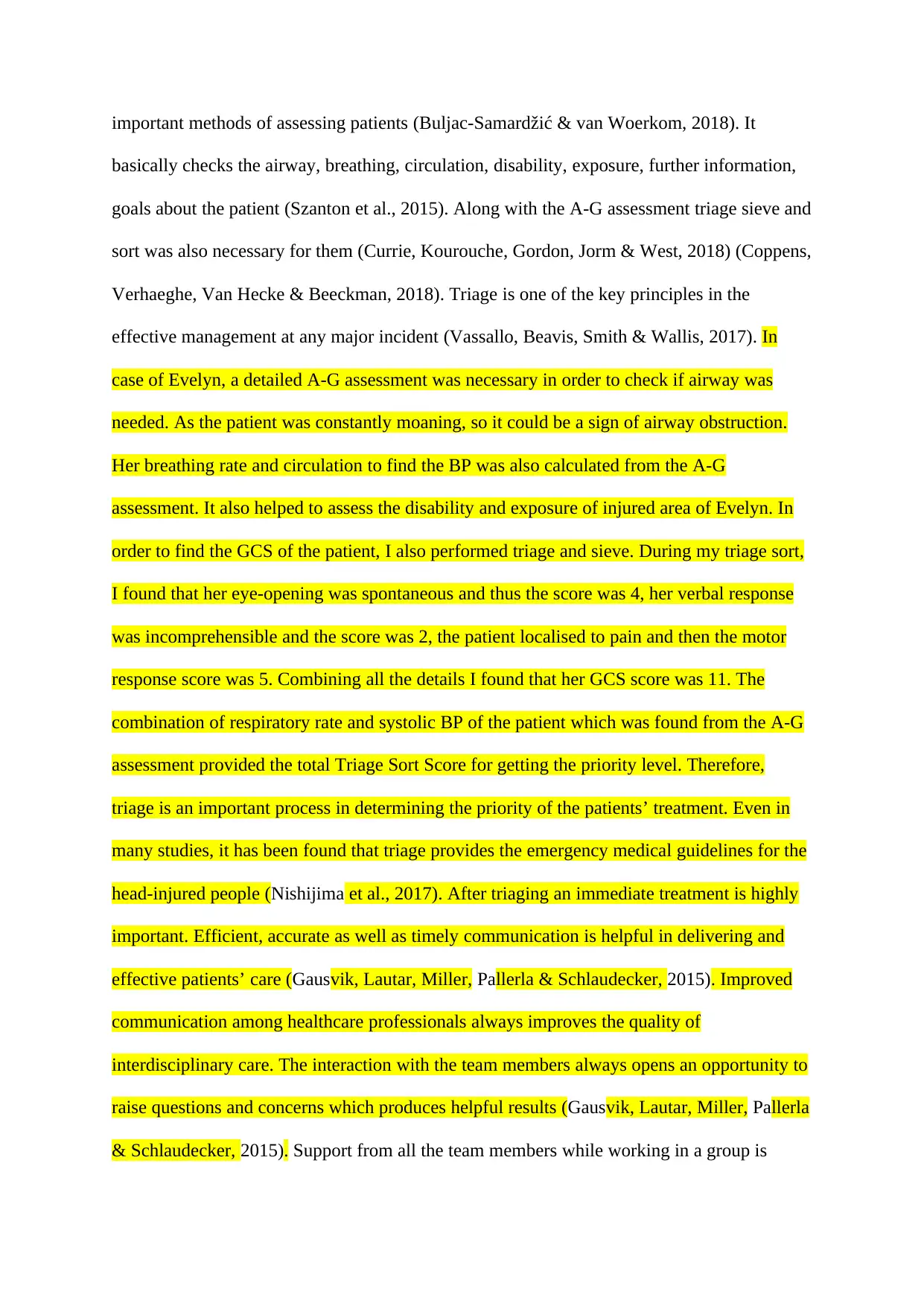
important methods of assessing patients (Buljac-Samardžić & van Woerkom, 2018). It
basically checks the airway, breathing, circulation, disability, exposure, further information,
goals about the patient (Szanton et al., 2015). Along with the A-G assessment triage sieve and
sort was also necessary for them (Currie, Kourouche, Gordon, Jorm & West, 2018) (Coppens,
Verhaeghe, Van Hecke & Beeckman, 2018). Triage is one of the key principles in the
effective management at any major incident (Vassallo, Beavis, Smith & Wallis, 2017). In
case of Evelyn, a detailed A-G assessment was necessary in order to check if airway was
needed. As the patient was constantly moaning, so it could be a sign of airway obstruction.
Her breathing rate and circulation to find the BP was also calculated from the A-G
assessment. It also helped to assess the disability and exposure of injured area of Evelyn. In
order to find the GCS of the patient, I also performed triage and sieve. During my triage sort,
I found that her eye-opening was spontaneous and thus the score was 4, her verbal response
was incomprehensible and the score was 2, the patient localised to pain and then the motor
response score was 5. Combining all the details I found that her GCS score was 11. The
combination of respiratory rate and systolic BP of the patient which was found from the A-G
assessment provided the total Triage Sort Score for getting the priority level. Therefore,
triage is an important process in determining the priority of the patients’ treatment. Even in
many studies, it has been found that triage provides the emergency medical guidelines for the
head-injured people (Nishijima et al., 2017). After triaging an immediate treatment is highly
important. Efficient, accurate as well as timely communication is helpful in delivering and
effective patients’ care (Gausvik, Lautar, Miller, Pallerla & Schlaudecker, 2015). Improved
communication among healthcare professionals always improves the quality of
interdisciplinary care. The interaction with the team members always opens an opportunity to
raise questions and concerns which produces helpful results (Gausvik, Lautar, Miller, Pallerla
& Schlaudecker, 2015). Support from all the team members while working in a group is
basically checks the airway, breathing, circulation, disability, exposure, further information,
goals about the patient (Szanton et al., 2015). Along with the A-G assessment triage sieve and
sort was also necessary for them (Currie, Kourouche, Gordon, Jorm & West, 2018) (Coppens,
Verhaeghe, Van Hecke & Beeckman, 2018). Triage is one of the key principles in the
effective management at any major incident (Vassallo, Beavis, Smith & Wallis, 2017). In
case of Evelyn, a detailed A-G assessment was necessary in order to check if airway was
needed. As the patient was constantly moaning, so it could be a sign of airway obstruction.
Her breathing rate and circulation to find the BP was also calculated from the A-G
assessment. It also helped to assess the disability and exposure of injured area of Evelyn. In
order to find the GCS of the patient, I also performed triage and sieve. During my triage sort,
I found that her eye-opening was spontaneous and thus the score was 4, her verbal response
was incomprehensible and the score was 2, the patient localised to pain and then the motor
response score was 5. Combining all the details I found that her GCS score was 11. The
combination of respiratory rate and systolic BP of the patient which was found from the A-G
assessment provided the total Triage Sort Score for getting the priority level. Therefore,
triage is an important process in determining the priority of the patients’ treatment. Even in
many studies, it has been found that triage provides the emergency medical guidelines for the
head-injured people (Nishijima et al., 2017). After triaging an immediate treatment is highly
important. Efficient, accurate as well as timely communication is helpful in delivering and
effective patients’ care (Gausvik, Lautar, Miller, Pallerla & Schlaudecker, 2015). Improved
communication among healthcare professionals always improves the quality of
interdisciplinary care. The interaction with the team members always opens an opportunity to
raise questions and concerns which produces helpful results (Gausvik, Lautar, Miller, Pallerla
& Schlaudecker, 2015). Support from all the team members while working in a group is
⊘ This is a preview!⊘
Do you want full access?
Subscribe today to unlock all pages.

Trusted by 1+ million students worldwide
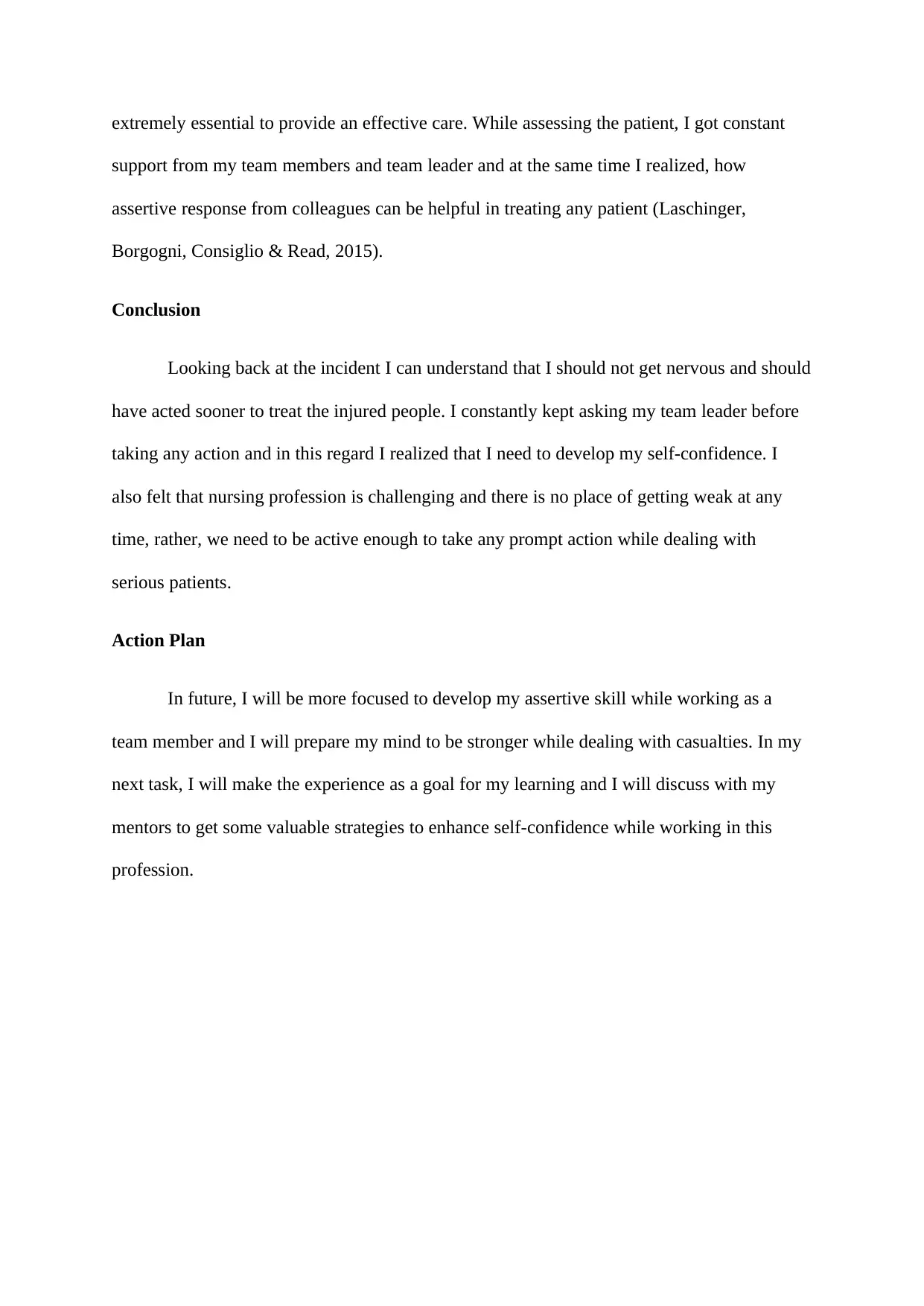
extremely essential to provide an effective care. While assessing the patient, I got constant
support from my team members and team leader and at the same time I realized, how
assertive response from colleagues can be helpful in treating any patient (Laschinger,
Borgogni, Consiglio & Read, 2015).
Conclusion
Looking back at the incident I can understand that I should not get nervous and should
have acted sooner to treat the injured people. I constantly kept asking my team leader before
taking any action and in this regard I realized that I need to develop my self-confidence. I
also felt that nursing profession is challenging and there is no place of getting weak at any
time, rather, we need to be active enough to take any prompt action while dealing with
serious patients.
Action Plan
In future, I will be more focused to develop my assertive skill while working as a
team member and I will prepare my mind to be stronger while dealing with casualties. In my
next task, I will make the experience as a goal for my learning and I will discuss with my
mentors to get some valuable strategies to enhance self-confidence while working in this
profession.
support from my team members and team leader and at the same time I realized, how
assertive response from colleagues can be helpful in treating any patient (Laschinger,
Borgogni, Consiglio & Read, 2015).
Conclusion
Looking back at the incident I can understand that I should not get nervous and should
have acted sooner to treat the injured people. I constantly kept asking my team leader before
taking any action and in this regard I realized that I need to develop my self-confidence. I
also felt that nursing profession is challenging and there is no place of getting weak at any
time, rather, we need to be active enough to take any prompt action while dealing with
serious patients.
Action Plan
In future, I will be more focused to develop my assertive skill while working as a
team member and I will prepare my mind to be stronger while dealing with casualties. In my
next task, I will make the experience as a goal for my learning and I will discuss with my
mentors to get some valuable strategies to enhance self-confidence while working in this
profession.
Paraphrase This Document
Need a fresh take? Get an instant paraphrase of this document with our AI Paraphraser
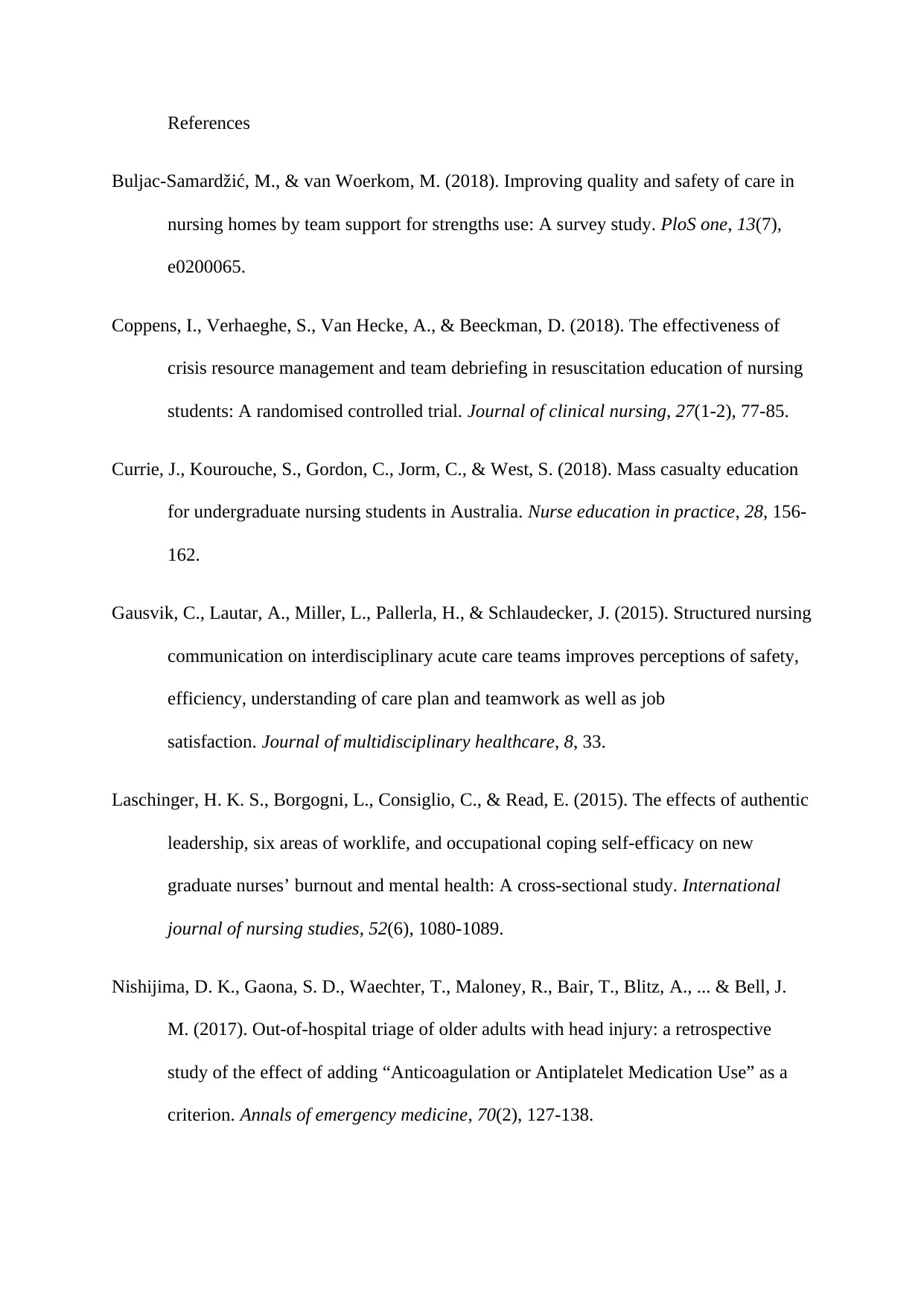
References
Buljac-Samardžić, M., & van Woerkom, M. (2018). Improving quality and safety of care in
nursing homes by team support for strengths use: A survey study. PloS one, 13(7),
e0200065.
Coppens, I., Verhaeghe, S., Van Hecke, A., & Beeckman, D. (2018). The effectiveness of
crisis resource management and team debriefing in resuscitation education of nursing
students: A randomised controlled trial. Journal of clinical nursing, 27(1-2), 77-85.
Currie, J., Kourouche, S., Gordon, C., Jorm, C., & West, S. (2018). Mass casualty education
for undergraduate nursing students in Australia. Nurse education in practice, 28, 156-
162.
Gausvik, C., Lautar, A., Miller, L., Pallerla, H., & Schlaudecker, J. (2015). Structured nursing
communication on interdisciplinary acute care teams improves perceptions of safety,
efficiency, understanding of care plan and teamwork as well as job
satisfaction. Journal of multidisciplinary healthcare, 8, 33.
Laschinger, H. K. S., Borgogni, L., Consiglio, C., & Read, E. (2015). The effects of authentic
leadership, six areas of worklife, and occupational coping self-efficacy on new
graduate nurses’ burnout and mental health: A cross-sectional study. International
journal of nursing studies, 52(6), 1080-1089.
Nishijima, D. K., Gaona, S. D., Waechter, T., Maloney, R., Bair, T., Blitz, A., ... & Bell, J.
M. (2017). Out-of-hospital triage of older adults with head injury: a retrospective
study of the effect of adding “Anticoagulation or Antiplatelet Medication Use” as a
criterion. Annals of emergency medicine, 70(2), 127-138.
Buljac-Samardžić, M., & van Woerkom, M. (2018). Improving quality and safety of care in
nursing homes by team support for strengths use: A survey study. PloS one, 13(7),
e0200065.
Coppens, I., Verhaeghe, S., Van Hecke, A., & Beeckman, D. (2018). The effectiveness of
crisis resource management and team debriefing in resuscitation education of nursing
students: A randomised controlled trial. Journal of clinical nursing, 27(1-2), 77-85.
Currie, J., Kourouche, S., Gordon, C., Jorm, C., & West, S. (2018). Mass casualty education
for undergraduate nursing students in Australia. Nurse education in practice, 28, 156-
162.
Gausvik, C., Lautar, A., Miller, L., Pallerla, H., & Schlaudecker, J. (2015). Structured nursing
communication on interdisciplinary acute care teams improves perceptions of safety,
efficiency, understanding of care plan and teamwork as well as job
satisfaction. Journal of multidisciplinary healthcare, 8, 33.
Laschinger, H. K. S., Borgogni, L., Consiglio, C., & Read, E. (2015). The effects of authentic
leadership, six areas of worklife, and occupational coping self-efficacy on new
graduate nurses’ burnout and mental health: A cross-sectional study. International
journal of nursing studies, 52(6), 1080-1089.
Nishijima, D. K., Gaona, S. D., Waechter, T., Maloney, R., Bair, T., Blitz, A., ... & Bell, J.
M. (2017). Out-of-hospital triage of older adults with head injury: a retrospective
study of the effect of adding “Anticoagulation or Antiplatelet Medication Use” as a
criterion. Annals of emergency medicine, 70(2), 127-138.
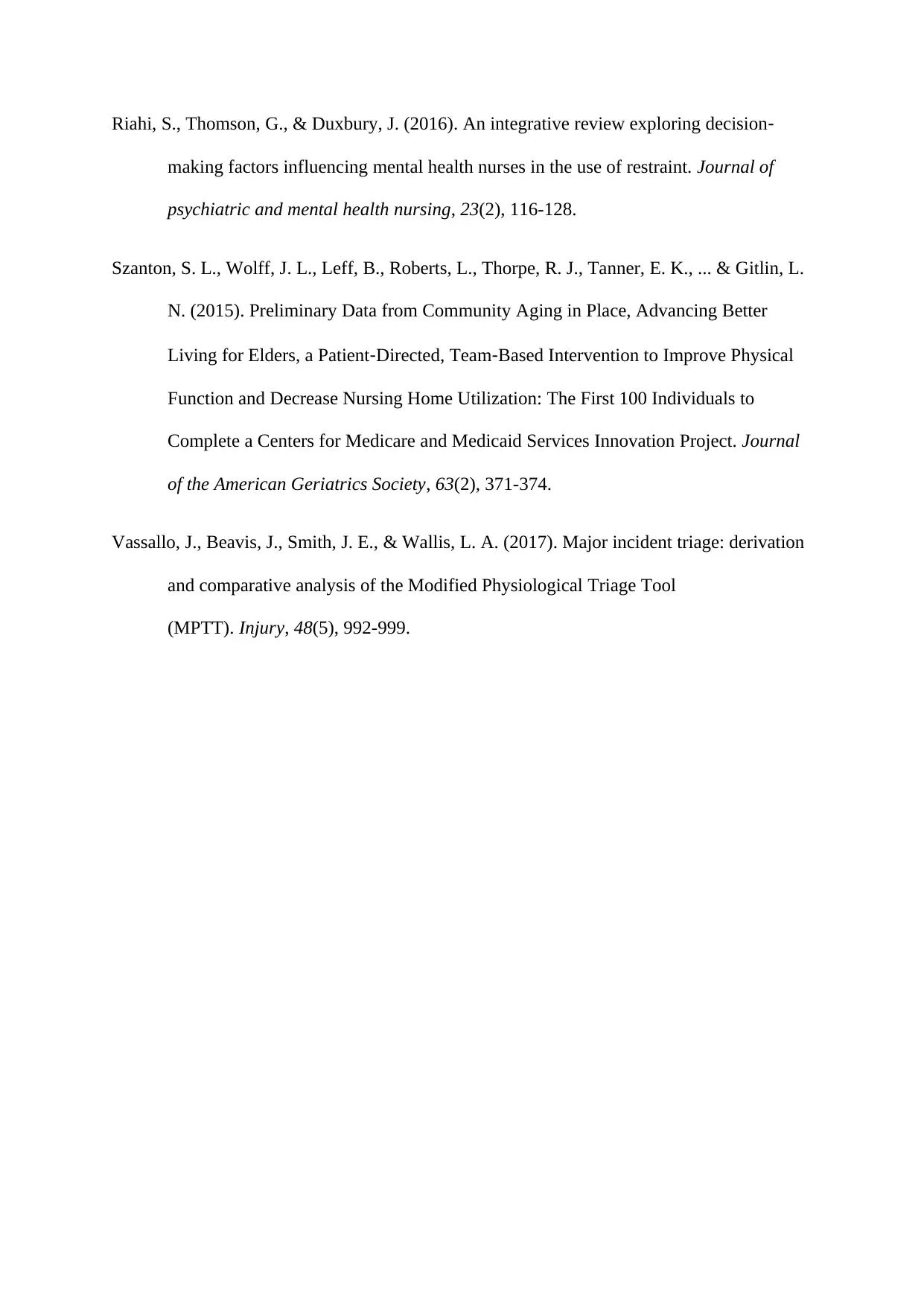
Riahi, S., Thomson, G., & Duxbury, J. (2016). An integrative review exploring decision‐
making factors influencing mental health nurses in the use of restraint. Journal of
psychiatric and mental health nursing, 23(2), 116-128.
Szanton, S. L., Wolff, J. L., Leff, B., Roberts, L., Thorpe, R. J., Tanner, E. K., ... & Gitlin, L.
N. (2015). Preliminary Data from Community Aging in Place, Advancing Better
Living for Elders, a Patient‐Directed, Team‐Based Intervention to Improve Physical
Function and Decrease Nursing Home Utilization: The First 100 Individuals to
Complete a Centers for Medicare and Medicaid Services Innovation Project. Journal
of the American Geriatrics Society, 63(2), 371-374.
Vassallo, J., Beavis, J., Smith, J. E., & Wallis, L. A. (2017). Major incident triage: derivation
and comparative analysis of the Modified Physiological Triage Tool
(MPTT). Injury, 48(5), 992-999.
making factors influencing mental health nurses in the use of restraint. Journal of
psychiatric and mental health nursing, 23(2), 116-128.
Szanton, S. L., Wolff, J. L., Leff, B., Roberts, L., Thorpe, R. J., Tanner, E. K., ... & Gitlin, L.
N. (2015). Preliminary Data from Community Aging in Place, Advancing Better
Living for Elders, a Patient‐Directed, Team‐Based Intervention to Improve Physical
Function and Decrease Nursing Home Utilization: The First 100 Individuals to
Complete a Centers for Medicare and Medicaid Services Innovation Project. Journal
of the American Geriatrics Society, 63(2), 371-374.
Vassallo, J., Beavis, J., Smith, J. E., & Wallis, L. A. (2017). Major incident triage: derivation
and comparative analysis of the Modified Physiological Triage Tool
(MPTT). Injury, 48(5), 992-999.
⊘ This is a preview!⊘
Do you want full access?
Subscribe today to unlock all pages.

Trusted by 1+ million students worldwide
1 out of 6
Related Documents
Your All-in-One AI-Powered Toolkit for Academic Success.
+13062052269
info@desklib.com
Available 24*7 on WhatsApp / Email
![[object Object]](/_next/static/media/star-bottom.7253800d.svg)
Unlock your academic potential
Copyright © 2020–2025 A2Z Services. All Rights Reserved. Developed and managed by ZUCOL.





